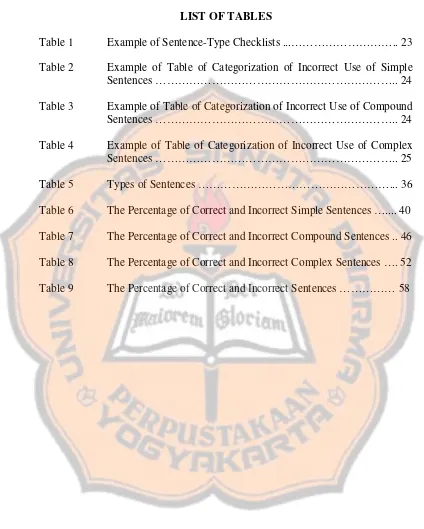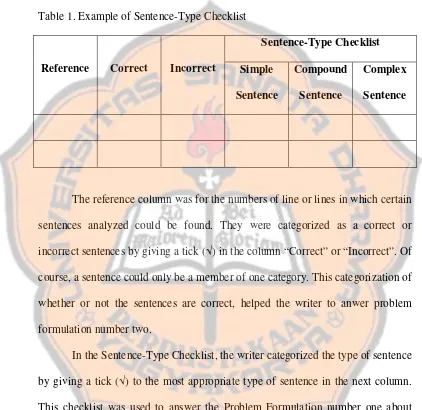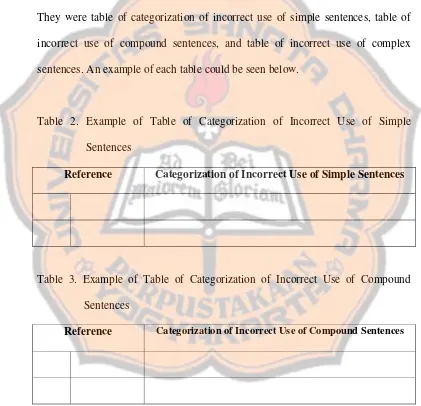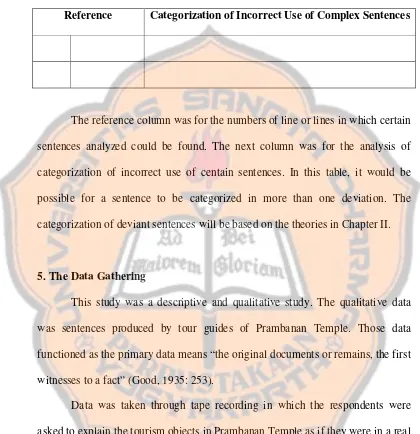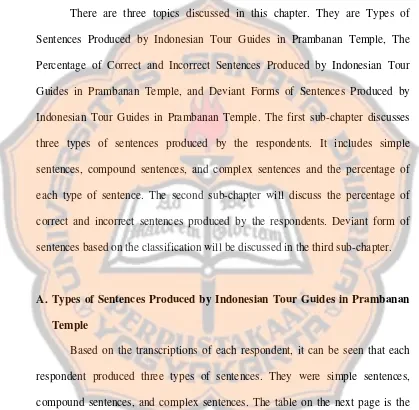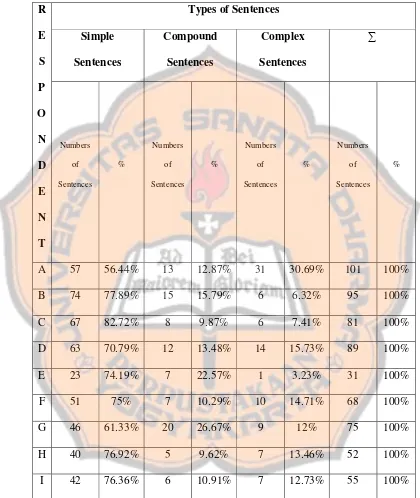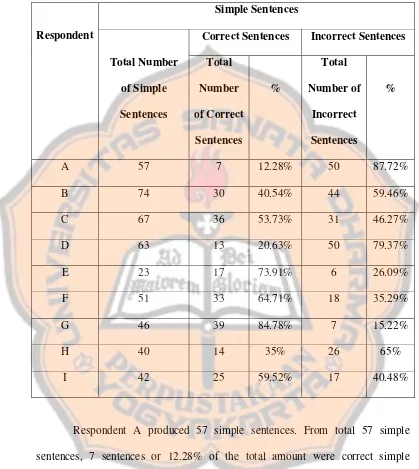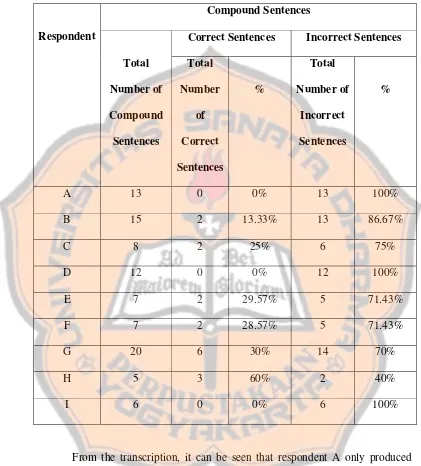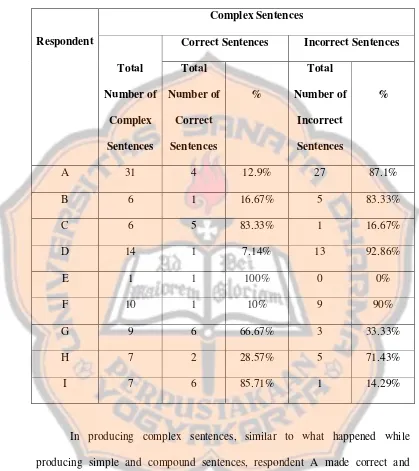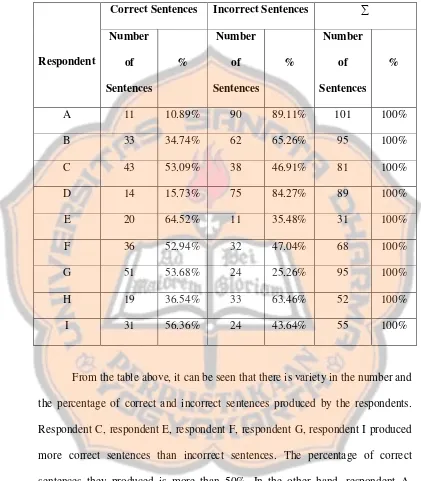x ABSTRACT
IDA AYU UTAMI DEWI. A Study of English Syntactic Sentence Structures of Indonesian Tour Guides in Prambanan Temple. Yogyakarta: Department of English Letters, Faculty of Letters, Sanata Dharma University, 2008.
This study is a study of tour guides of Prambanan Temple’s language in relation to their mastery of English syntax. Their competency of English syntax is a must, remembering that English is a means of communication when they carry out their duties.
There are three problems which are discussed in this study. They are types of sentences, the percentage of correct and incorrect sentences, and deviant forms of sentences produced by Indonesian tour guides in Prambanan Temple.
This study is a descriptive qualitative study. The object of this study is sentences produced by tour guides in Prambanan Temple. Since this study concentrates on grammatical aspects of sentences, the approach of syntax of English language was used. However, syntax used in this study is only related to sentence constructions. The population of this study was 17 active tour guides in Prambanan Temple. Nine samples were taken using probability random sampling. Instruments used in gathering the data were questionnaires. In analyzing the data, the writer used checklists and tables. The data was taken through tape recording in which the respondents were asked to explain tourism objects in Prambanan Temple as if they were in a real guiding process.
xi ABSTRAK
IDA AYU UTAMI DEWI. A Study of English Syntactic Sentence Structures of Indonesian Tour Guides in Prambanan Temple. Yogyakarta: Jurusan Sastra Inggris, Fakultas Sastra, Universitas Sanata Dharma, 2008.
Skripsi ini merupakan sebuah studi tentang bahasa para pramuswisata di Candi Prambanan yang dihubungkan dengan penguasaan tata bahasa Bahasa Inggris. Keahlian dalam tata bahasa Bahasa Inggris mutlak diperlukan mengingat Bahasa Inggris adalah alat berkomunikasi ketika para pramuwisata menjalankan tugas.
Terdapat tiga rumusan masalah yang dibahas dalam studi ini. Rumusan masalah tersebut meliputi tipe kalimat, persentase kalimat benar dan kalimat salah, serta pola kalimat yang salah yang diproduksi oleh para pramuwisata di Candi Prambanan.
Studi ini merupakan penelitian desktiptif kualitatif. Obyek penelitian ini adalah kalimat-kalimat yang dihasilkan oleh pramuwisata. Dikarenakan penelitian ini difokuskan pada aspek tata bahasa, pendekatan sintaksislah yang digunakan. Akan tetapi, aspek sistaksis yang digunakan dibatasi pada aspek pola kalimat. Populasi dalam penelitian ini adalah 17 pramuwisata. Sampel berjumlah 9 orang yang diperoleh melalui sistim sampel probabilitas acak. Instrumen yang digunakan dalam penjaringan data adalah kuesioner. Dalam proses analisa, penulis menggunakan daftar kalimat dan tabel. Data dijaring melalui proses perekaman yaitu para responden diminta untuk menjelaskan obyek wisata di Candi Prambanan selayaknya mereka dalam proses memandu yang sebenarnya.
A STUDY OF
ENGLISH SYNTACTIC SENTENCE STRUCTURES
OF INDONESIAN TOUR GUIDES IN PRAMBANAN TEMPLE
AN UNDERGRADUATE THESIS
Presented as Partial Fulfillment of the Requirements for the Degree of Sarjana Sastra
in English Letters
By
IDA AYU UTAMI DEWI
Student Number: 034214077
ENGLISH LETTERS STUDY PROGRAMME DEPARTMENT OF ENGLISH LETTERS
FACULTY OF LETTERS SANATA DHARMA UNIVERSITY
i
A STUDY OF
ENGLISH SYNTACTIC SENTENCE STRUCTURES
OF INDONESIAN TOUR GUIDES IN PRAMBANAN TEMPLE
AN UNDERGRADUATE THESIS
Presented as Partial Fulfillment of the Requirements for the Degree of Sarjana Sastra
in English Letters
By
IDA AYU UTAMI DEWI
Student Number: 034214077
ENGLISH LETTERS STUDY PROGRAMME DEPARTMENT OF ENGLISH LETTERS
FACULTY OF LETTERS SANATA DHARMA UNIVERSITY
v
ACKNOWLEDGEMENTS
Above all, I would like to raise the highest praise and gratitude to Jesus
Christ, the Almighty God, and Mother Mary. You are still by my side for every single moment of my life. For You up above, I would be forever thankful.
People fail but they stand again to see the world in a different and more
truthful way. That makes them real humans. In fact, without these people I believe
I cannot live my life the way I do.
To my Dad, whose words always calm me down, whose prayers keep me stand, whose jokes always make me smile or even laugh, and whose perspectives
and life inspire me, words are never enough to express my gratefulness. To my
Mom who makes me the way I am today, my deepest salutation and thankfulness are dedicated to you. To all my encouraging cousins, Ria, Cik Evi, Ko Elias, Ko Thomas, Cik Stanny, Ko Donny, Ko David, Ade, Mbok Kondi, I thank you all for your never ending support.
I also feel indebted to my advisor, Dr. Fr. B. Alip, M.Pd., M.A., who is being very tolerant and helpful, and to my co-advisor, Adventina Putranti, S.S., M.Hum. It is impossible for me to finish my thesis without the uncountable helps from you. To all my lecturers in English Letters Department, I am grateful that
you, in a phase of my life, fulfill me with knowledge.
My thanks and appreciation are also for people of HPI Prambanan, Mr. Topo Wibowo, Mr. Wagiyo, Mr. Slamet, Mr. Suradi, Mr, Subarno, Mr. Eddy Suharyanto, Mr.Ismanta, Mr. Supriyadi, Mr. Dwi Wibowo, Mr. Murtejo,
very welcome and very cooperative while I conducted this research. Your
thoughts and suggestions are essential for this research and for me personally.
Knowing you is a great opportunity.
To my “second” family in Yogyakarta, The Satmokos, Bapak, Ibu, Bu Tut, Bi’ Nah, Yani, Imala, thank you for your support. No doubt, being with you for the past five years give me a precious moment in my life. To my true
cheerleaders, Mbak Ketrin, Dek Rani, Titi, and Sonia “Mpok Atik”, thank you for your support in my good and bad times.
To my college friends of English Letters of the year 2003 especially
Cindy, Ndu, Lina, Ami, Ana, Dian, Icha, Hartyo, Budi, Vino, Kethex, Dion, we have shared good and bad times. That makes you all are marked in my life.
Thank you for your laughs, tears, hopes, prayers, and supports for me.
To my forever friends, Kartika, Noel, Amen, Nyo, Yogi, Mira,
Gottardo, Wawan and Ndong, once you entered my life, that is where you always. No space and no time will separate us from being to each other.
Finally, to my beloved one, Hariyus Kristian Valentino, I am grateful for lending me your ears to hear my thoughts, your eyes to see my good and bad side
and to always correct me when I am wrong, and your shoulder for me to cry on.
We share so many times together which lead me to be forever happy. I thank God
for every single moment with you.
vii Indonesian Tour Guides in Prambanan Temple ……….. 39
C. Deviant Forms of Sentences of Indonesian Tour Guides in Prambanan Temple ……….. 59
CHAPTER V: CONCLUSION ……….. 82
A. Conclusion ……….. 82
BIBLIOGRAPHY ……… 85
APPENDICES Appendix 1. Letter of Permission of Research ……….. 88
Appendix 2. Letter of Approval (from HPI Prambanan)……….... 89
Appendix 3.1 Sentences Produced by Respondent A ……… 90
Appendix 3.2 Sentences Produced by Respondent B ……… 94
Appendix 3.3 Sentences Produced by Respondent C ……… 98
Appendix 3.4 Sentences Produced by Respondent D ……… 101
Appendix 3.5 Sentences Produced by Respondent E ……… 105
Appendix 3.6 Sentences Produced by Respondent F ……… 107
Appendix 3.7 Sentences Produced by Respondent G ……… 110
Appendix 3.8 Sentences Produced by Respondent H ……… 114
ix
LIST OF TABLES
Table 1 Example of Sentence-Type Checklists ...……….. 23
Table 2 Example of Table of Categorization of Incorrect Use of Simple Sentences ……….. 24
Table 3 Example of Table of Categorization of Incorrect Use of Compound Sentences ……….. 24
Table 4 Example of Table of Categorization of Incorrect Use of Complex Sentences ……….. 25
Table 5 Types of Sentences ………... 36
Table 6 The Percentage of Correct and Incorrect Simple Sentences ….... 40
Table 7 The Percentage of Correct and Incorrect Compound Sentences .. 46
Table 8 The Percentage of Correct and Incorrect Complex Sentences …. 52
x
ABSTRACT
IDA AYU UTAMI DEWI. A Study of English Syntactic Sentence Structures of Indonesian Tour Guides in Prambanan Temple. Yogyakarta: Department of English Letters, Faculty of Letters, Sanata Dharma University, 2008.
This study is a study of tour guides of Prambanan Temple’s language in relation to their mastery of English syntax. Their competency of English syntax is a must, remembering that English is a means of communication when they carry out their duties.
There are three problems which are discussed in this study. They are types of sentences, the percentage of correct and incorrect sentences, and deviant forms of sentences produced by Indonesian tour guides in Prambanan Temple.
This study is a descriptive qualitative study. The object of this study is sentences produced by tour guides in Prambanan Temple. Since this study concentrates on grammatical aspects of sentences, the approach of syntax of English language was used. However, syntax used in this study is only related to sentence constructions. The population of this study was 17 active tour guides in Prambanan Temple. Nine samples were taken using probability random sampling. Instruments used in gathering the data were questionnaires. In analyzing the data, the writer used checklists and tables. The data was taken through tape recording in which the respondents were asked to explain tourism objects in Prambanan Temple as if they were in a real guiding process.
xi
ABSTRAK
IDA AYU UTAMI DEWI. A Study of English Syntactic Sentence Structures of Indonesian Tour Guides in Prambanan Temple. Yogyakarta: Jurusan Sastra Inggris, Fakultas Sastra, Universitas Sanata Dharma, 2008.
Skripsi ini merupakan sebuah studi tentang bahasa para pramuswisata di Candi Prambanan yang dihubungkan dengan penguasaan tata bahasa Bahasa Inggris. Keahlian dalam tata bahasa Bahasa Inggris mutlak diperlukan mengingat Bahasa Inggris adalah alat berkomunikasi ketika para pramuwisata menjalankan tugas.
Terdapat tiga rumusan masalah yang dibahas dalam studi ini. Rumusan masalah tersebut meliputi tipe kalimat, persentase kalimat benar dan kalimat salah, serta pola kalimat yang salah yang diproduksi oleh para pramuwisata di Candi Prambanan.
Studi ini merupakan penelitian desktiptif kualitatif. Obyek penelitian ini adalah kalimat-kalimat yang dihasilkan oleh pramuwisata. Dikarenakan penelitian ini difokuskan pada aspek tata bahasa, pendekatan sintaksislah yang digunakan. Akan tetapi, aspek sistaksis yang digunakan dibatasi pada aspek pola kalimat. Populasi dalam penelitian ini adalah 17 pramuwisata. Sampel berjumlah 9 orang yang diperoleh melalui sistim sampel probabilitas acak. Instrumen yang digunakan dalam penjaringan data adalah kuesioner. Dalam proses analisa, penulis menggunakan daftar kalimat dan tabel. Data dijaring melalui proses perekaman yaitu para responden diminta untuk menjelaskan obyek wisata di Candi Prambanan selayaknya mereka dalam proses memandu yang sebenarnya.
1
CHAPTER I
INTRODUCTION
This chapter discusses four parts, namely the Background of the Study,
Problem Formulation, Objectives of the Study, and Definition of Terms. In the
Background of the Study, the writer will give reasons why the topic is chosen and
worth studying. In the Problem Formulation, there are three questions related to
the topic which later will be discussed and answered in Chapter IV. Objectives of
the Study is a part where the writer will state aims of the study the writer
conducts. Definition of Terms will describe four definitions of specific terms used
in the title and in the Problem Formulation according to several experts. They are
descriptions of syntax, sentence, and tour guides.
A. Background of the Study
It is certain that nowadays English is considered as one of international
languages besides French and Chinese because it is used by most people in most
countries in the world as their native language as in the United States of America,
United Kingdom, Ireland, New Zealand, Canada, South Africa, and Australia
where English is used in their daily live and the language they know since they
were born, as their second language as in Malaysia, Pakistan, Nigeria, Kenya,
South Korea, Ethiopia, Burma, and India, or as their foreign language as in
English is also considered one of important languages since it is used in
many fields of human life, for examples in educational field, public
administration, science and technology, mass media, international entertainment,
publicity, and in literature (Strevens, 1980: 73). Recently, English is a
requirement for working people. They have to master English, at least, passively.
One of the working fields which requires their employees to master English is
tourism since this field deals with people from foreign countries that usually use
English as their means of communication.
Yogyakarta as one of the tourism cities in Indonesia has many interesting
places to visit. One of them is Prambanan Temple area which consists of many
heritage places such as Siwa Temple, Brahma Temple, and Wishnu Temple
(Purwadi, 2005: 391). Many tourists are eager to visit those heritage places inside
Prambanan Temple area because they find those places interesting and they want
to know more about the history behind those heritage places.
In order to achieve what they want, tourists who cannot speak Indonesian
need tour guides who are in charge of giving direction and explanation about
heritage places in Prambanan Temple. Considering the fact, it is clear that all tour
guides of Prambanan Temple are required to be able to speak English fluently
when they carry out their duty. However, the writer found out that tour guides in
Prambanan Temple found difficulties when they have to speak in English. They
lack English competence, particularly their grammar skill.
Gass and Selinker in their book Second Language Acquisition: An
with which we can produce an infinite set of sentences” (1994: 8). It involves
ability to “combine words to form phrases, and phrases to form sentences”
(Fromkin, 1991: 6). In fact, the combination of those elements are not random.
English sentence has its own grammar and structures of forming sentences.
Hence, “knowing a language means knowing its grammar” (Haegeman and
Guéron, 1999: 16).
However, understanding and mastering second languages and foreign
languages may be difficult. These difficulties may range from the irregular
spelling of second languages and foreign languages to interference of speaker’s
mother tongue. In addition, most Indonesian learners of English have difficulty
mastering the English system of sentence construction because English sentence
structure contains complexities and because their contact with English is generally
very limited (Nuryanto, 1979: v).
Remembering that the most important function of language is as a means
of communication and interaction (Alwasilah, 1993: 89), tour guides are supposed
to encounter these problems and perform as perfect as possible when they talk to
English-speaking tourists because “undoubtedly the minimum standard of
performance which any ordinary learner should aim at is one which is easily
understood by the native speaker of English” (Gimson, 1975: 2). When tour
guides can perform well, there will be no misunderstanding so that the
communication and interaction between tour guides and tourists work well. By
Based on the fact, the writer wants to study tour guides in Prambanan
Temple in relation to their mastery of English syntax as a mean of communication
and as the basic requirement to carry out their duties.
B. Problem Formulation
There are three problems discussed in this study. Those three problems are
formulated in the following questions.
1. What types of sentences are produced by Indonesian tour guides in
Prambanan Temple?
2. What is the percentage of correct and incorrect sentences produced by
Indonesian tour guides in Prambanan Temple?
3. What are deviant forms of sentences produced by Indonesian tour
guides in Prambanan Temple?
C. Objectives of the Study
This research was an attempt to study the character of tour guides in
Prambanan Temple while they were guiding English speaking tourists. The
character to be investigated was their competency in producing English sentences.
Three areas which were examined in this study were types of sentences produced
by tour guides in Prambanan Temple, the percentage of correct and incorrect
sentences produced by Indonesian tour guides in Prambanan Temple, and deviant
D. Some Assumptions in the Research
There are two assumptions in the research in order to make the research
valid. The data which was given by each tour guide during the process of data
gathering was assumed to be their actual style of guiding tourists in Prambanan
Temple.
It is also assumed that tour guides gave their very best and seriousness
while giving the data. Their seriousness was very important because it might
represent their factual competency in English.
E. Definition of Terms
Some definitions of linguistic and tourism terminologies are given below
to avoid misunderstanding. The definitions of terms given here are definitions of
syntax, sentence, and tour guides.
1. Syntax
First of all, we need to know the etymology of the word “syntax”.
According to Crystal, “syntax” was taken from Latin, “syntaxis”, which earlier
was taken from Greek “syn + assein” mean “together + arrange” (1995: 197).
Based on its etymology, “syntax” means “arrange to be together”.
Aarts defines syntax in two ways. First, syntax is “a part of grammar that
concerns itself with the structure of sentences” (1997: 3), and second, syntax is
According to Finegan (2004: 148), syntax is “the part of grammar that
governs the form of strings by which language users make statements, ask
questions, give directives, and so on”.
Radford says that “syntax concerned with the ways in which words can be
combined together to form phrases and sentences” (2001: 1).
Kroeger in his book Analyzing Syntax: A Lexical – functional Approach,
states that syntax is “the branch of linguistics which seeks to describe and account
for the arrangement of words in a sentence” (2004: 4).
The last author who defines “syntax” is Fromkin, who says that syntax is
“the rules of sentence formation, the component of mental grammar that
represents speaker’s knowledge of the structure of phrases and sentences” (2003:
596).
2. Sentence
In his book English Syntax and Argumentation, Aarts defines sentence as
“a string of words that begins in a capital letter and ends in a full stop and is
typically used to express a state of affairs in the world” (1997: 3).
According to Crystal, sentence is “the largest structural unit that displays
stateable grammatical relationships, not dependent on any other structure” (1995:
3. Tour Guides
There are several authors who define what tour guide is. Some of them are
Mancini and Pond. Mancini defines a tour guide as “someone who takes people
on sightseeing excursions of limited duration” (1990: 5), and Pond defines tour
guide as “any individual who leads groups and provides commentary for them”
(1993: 260). In addition, in the United Kingdom, aguide is also called “a courier”
which according to Dictionary of Travel, Tourism, and Hospitality, it means “a
person employed by the tour organizer and escorting a group tour who may also
act as a guide.”
Mancini in his book Conducting Tours: A Practical Guide states that
based on the place of doing the job, guides are divided into two kinds, on-site
guide and city guide. On-site guide means “one who conducts tours of one or
several hours at a specific building, attraction, or limited area,” whereas a city
guide means someone who “points out and comment on the highlights of a city,
usually from a motor coach, mini-bus, or van” (1990: 5). Here, tour guides in
Prambanan Temple is considered on-site guides because they conduct tours for
8
CHAPTER II
THEORETICAL REVIEW
Theoretical Review in this study covers two main parts, Review of Related
Theories, and Theoretical Framework. In the Review of Related Theories, the
writer will state four theories related to the study which are beneficial in analyzing
data. Theoretical Framework explains the contribution of the theories in solving
the problems stated in the Problem Formulation.
A. Review of Related Theories
The first sub-chapter contains four relevant theories used in analyzing
data. Those theories are Theories on Clauses and Sentences, Theories on Simple
Sentences, Theories on Compound Sentences, and Theories on Complex
Sentences.
1. Theories on Clauses and Sentences
This sub-chapter is divided into four segments. They are Clauses versus
Sentences, Basic Types of English Clauses, Elements of English Clauses, and
a. Clauses versus Sentences
Efforts to understand the meaning of clauses and sentences may lead to
confusion at a certain stage because they have a similar characteristic.
According to Quirk (1972: 342), a clause is “a unit that can be analyzed
into elements” in which it is grammatical with a finite verb and “forming part of a
sentence” (Burton, 1982: 140). For example in this utterance I paid the boy who
delivered the newspapers, there is one sentence which is formed from two clauses,
I paid the boy and who delivered the newspapers. The first clause is an
independent utterance and the other is not and cannot stand by itself. So, “when
the subject and predicate express a complete idea, the clause is called a sentence”
(Carter and Skates, 1990: 50).
A sentence also means “the finite string of words which we communicate”
(Peters, 2004: 491). Many utterances in a conversation do not have full subject
and predicate but they are understood through the context.
b. Basic Types of English Clauses
According to Crystal (1995: 221) and Quirk (1972: 343), English clause
can be divided into seven basic types.
Type 1: Subject + Verb, e.g. The children were sleeping.
Type 2: Subject + Verb + Object, e.g. Somebody stole the key.
Type 3: Subject + Verb + Complement, e.g. They are starving.
Type 4: Subject + Verb + Adverbial, e.g. We were there.
Type 6: Subject + Verb + Object + Complement, e.g. We have proved him wrong.
Type 7: Subject + Verb + Object + Adverbial, e.g. The director put the script in his drawer.
c. Elements of an English Clause
In a clause, there are at least two elements present. Whenever these two
elements absent, a clause cannot be called a clause. Those two elements are
subject and predicate.
A subject is “the part that names the person or thing about which
something is said” (Burton, 1982: 139). It has several functions. First, subject
controls whether the verb is singular or plural in the third person of the present
tense. Second, subject controls the form of certain objects and complements.
The second required element of English clause is a predicate. A predicate
contains a verb phrase (VP) generally referring to an action performed by the
subject (Wilson, 1998 as cited in
http://www.uncp.edu/home/canada/work/markport/language/grammar/spg2001/sy
ntax.htm, accessed on August 20, 2007) and it “affirms something about the
subject (Ducrot and Todorov, 1981: 210)”. The predicate itself can be analyzed
into four elements. They are verb, object, adverbial, and complement.
A verb plays a central role in clause structure and it must be a verb phrase
(VP). Verbs have four kinds of forms, the simple form, the simple past (regular
21). The simple form is found in the dictionary with no ending, for example, see,
watch, understand. In other words, the simple form is the basic form of a verb.
The simple past form ends in –ed for regular verbs, for example, finished, waited,
played. However, irregular verbs do not end in –ed, for example, saw, went, put.
The past participle also ends in –ed for regular verbs, but with addition of have or
has for present perfect tense, and had for past perfect tense, for example, has left,
have become. The present participle ends in –ing for both regular and irregular
verbs. It is used in progressive tense, for example, listening, speaking.
An object element is a noun phrase (NP) that follows the subject and verb
in declarative clauses. There are two types of object, indirect (IO) and direct
object (DO). The indirect object refers to an animate being which is the recipient
of the action. The direct object refers to inanimate things. In the sentence Maria
provides them a large amount of money, the word them is the indirect object, and
the noun phrase a large amount of money is the direct object.
An adverbial can be an adverbial, adverbial phrase, adverbial clause, noun
phrase, or prepositional phrase that expresses a wide range of meaning, such as
manner (adverbial of manner), place (adverbial of place), and time (adverbial of
time). Adverbial is generally mobile because it can be placed in several possible
positions in the clause, though it is most common at the end. Adverbial differs
from other clause elements in the way that there can be an indefinite number of
them in a single clause. Though it expresses a wide range of meaning, it is
A complement is “an element which is needed to complete the meaning of
the head” (Dwijatmoko, 2002: 6). It expresses a meaning which adds to that of
other clause elements, either the subject (subject complement) or the object
(object complement) (Crystal, 1995: 221), for example, The news on the World
War II (subject complement) and We consider him a genius (object complement).
A complement might be a noun phrase (NP), adjective phrase, or a clause. The
difference between an object and a complement is in the way that a complement
does not become the subject through a passive transformation.
d. Classes of English Clauses
Curme (1931: 1) states that sentences are divided into three classes, which
are simple sentence, compound sentence, and complex sentence.
2. Theories on Simple Sentences
According to Aarts and Aarts (1982: 82), a simple sentence can be defined
as “a sentence in which none of the functions is realized by a clause. A simple
sentence does not contain an embedded (or subordinate) sentence as realization of
one of its functions.”
Curme defines simple sentence in a more simple way that simple sentence
is a sentence having one independent proposition (1931: 1).
Simple sentence has three forms of sentence. They are exclamatory,
1. An exclamatory sentence is a sentence uttering an outcry or giving
expression to a command, wish, or desire, often closing with an
exclamation point, for example, What a fine ring she received for her
engagement!
2. A declarative sentence states a fact, closing with a period. In this type of
sentence, the subject is present and generally preceded the verb, for
example, Ann brought a cake for her mother’s birthday.
3. An interrogative sentence is a sentence asking for a question, closing with
an interrogation point. This type of sentence is marked in three ways:
Yes/No question (for example, Do you agree with her statement?),
WH-Question (for example, What is her name?), and Question Tag (for
example, The mail is received, isn’t it?).
Simple sentences have two functions. First, it is emotive, for example, it
expresses an expression of will, emotions, moods, etc., and second, it makes a
statement, or, in the case of a question, calls for a statement (Curme, 1931: 1).
In analyzing simple sentences, there are three aspects that should be
noticed. They are in which the sentence contains subject or not, in which the
sentence contains one single verb or not, and concord.
A finite verb is “a verb phrase in which the first or only word is a finite
verb, the rest of the verb phrase (if any) consisting of non-finite verbs” (Quirk,
Concord is “a harmony among the elements of a sentence so that the
message to deliver has a logical meaning and is correct grammatically”
(Pardiyono, 2001: 16). The categories of concord are subject – verb concord,
subject – verb concord with paired conjunctions, pronoun concord and parallel
structure.
3. Theories on Compound Sentences
According to Curme, compound sentence “consists of different
independent prepositions or members” (1931: 161).
Aarts and Aarts in their book entitled English Syntactic Structures:
Functions & Categories in Sentence Analysis (1982: 86) differentiate compound
sentence in three types:
1. simple sentence + simple sentence (+ simple sentence)
For example, I have brought a new suit, but it does not fit me.
2. any combination of simple and complex sentence
For example, He thinks that I am in love with her and he is right.
3. complex sentence + complex sentence (+ complex sentence)
For example, I hope he would tell me the truth but I know that he is a
coward.
To combine each sentence in compound sentence, it may be used one of
1. coordinator (and, but, and or, called “pure coordinator” and so, yet,
called “not pure coordinator”), for example, The menu didn’t meet our
appetite, so we left the restaurant.
2. correlatives: both… and…, either… or…, neither… nor…, not only…
but also…. For example, Both John and Paul hate big houses, and
Neither I nor my colleagues like our new boss.
4. Theories on Complex Sentences
Curme states that complex sentence consists of “one independent
preposition and one or more subordinate clauses” (Curme: 1931: 1). It gives one
of them superior status. The superior one is known as the main clause (or
principal clause), while the other is subordinated to it and is called the subordinate
(or dependent) clause since it cannot stand by itself. The subordinate clause can be
divided into three categories, namely relative clause, noun clause, and adverbial
clause.
Relative clause “attach further information to nouns or pronouns in or the
main clause” (Peters, 2004: 108). In relative clause, relative pronouns are used in
specific conditions. In defining relative clause, relative pronouns used for persons
are who/that (for subject), whom/who/that (for object), and whose (for
possessive). For things, which/that (for subject), which/that (for object), and
whose/of which (for possessive) are used. The examples of defining relative clause
are The girl that he hit is my sister, and I brought a new book which will make you
definite” (Thomson and Martinet, 1986: 85). It adds something to it by giving
more information which is not essential and can be omitted without causing
confusion. The difference of the use of relative pronoun is that in non-defining
relative clause, that is not used. The example of the use of non-defining relative
clause is Her brother, who is actually a big liar, said that he once saw a UFO in
his yard.
According to Peters, noun clauses “take the place of a noun or noun phrase
in the main clause” (2004: 108), for example, They understand what their parents
talk about (as object) and What their parents talk about needs some understanding
(as subject).
Peters states that “adverbial clauses attach further information to the verb
of the main clause, detailing how, when, where, or why the action or event took
place” (2004: 108). Adverbials answer the question of how, when, where, why,
concession, condition, comparison, and result.
B. Theoretical Framework
In conducting this research, the writer needs the theories that have been
discussed. They are theories on clauses and sentences, theories on simple
sentences, theories on compound sentences, and theories on complex sentences.
In Theories on Clauses and Sentences there are ten authors whose theories
were helping in analyzing the data. They were theories from Quirk (1972), Burton
(1982), Carter and Skates (1990), Peters (2004), Crystal (1995), Wilson (1998),
Theories on simple sentences are very useful in understanding and
analyzing the data, especially those which concerned with simple sentences. The
writer takes theories on simple sentences according to Aarts and Aarts (1982),
Curme (1931), Quirk (1985), and Pardiyono (2001).
Theories on compound sentences will surely be helpful in analyzing
problems stated in the Problem Formulation. Theories from Curme (1931), and
Aarts and Aarts (1982) are selected.
The writer will also make use the theories on complex sentences proposed
by Curme (1931), Peters (2004), and Thomson and Martinet (1986) for analyzing
18
CHAPTER III
METHODOLOGY
This chapter covers three parts, Object of the Study, Approach of the
Study, and Method of the Study. Object of the Study discusses the data or object
of this study and at the end of this part, the writer states in brief what the work is
generally about. In the Approach of the Study, the writer explains the approach to
analyze the work. Method of the Study covers six sub-parts about the procedures
of analyzing the work.
A. Object of the Study
The object or the data of this study are sentences produced by tour guides
in Prambanan Temple.
In general, this study concerns about analyzing grammatical aspects of
English sentences produced by tour guides of Prambanan Temple. The analysis
covers types of sentences, the percentage of correct and incorrect sentences, and
deviant forms of sentences made by the respondents.
B. Approach of the Study
Since this study analyzes grammatical aspects of English sentences created
by tour guides of Prambanan Temple, it is obvious that this study will use the
approach of syntax of English language. However, the approach of syntax used in
C. Method of the Study
Method of the Study includes six parts. They are the Population of the
Study, the Sampling, Setting, the Research Instruments, the Data Gathering and
the Data Analysis.
1. The Population of the Study
Since this study intended to analyze types of sentences, the percentage of
correct and incorrect sentences, and deviant sentences made by tour guides in
Prambanan Temple, it is apparent that the population of this study was tour guides
in Prambanan Temple. The reason of choosing this population was because
Prambanan Temple is one of the most famous tourism objects in Indonesia in
general and in Yogyakarta in particular. Many tourists, both local tourists and
foreigners come to this place. As foreigners are common in Prambanan Temple,
English is as well familiar. It was assumed that all tour guides in Prambanan
Temple spoke English. The writer wanted to know whether or not they produced
good English.
The total population of tour guides in Prambanan Temple was thirty five
persons. However, in fact, there were only seventeen active tour guides. This
condition was due to the rest eighteen tour guides left this job after the earthquake
which happened in May 27, 2006 and some of them quit this job. All of the
members of the population were not college-educated. They were high-school
The sex of the population was 100% male. Actually once there were
female tour guides but they left this job because of personal affairs, for example,
they got married and had to take care of their families. The management did not
have a standard about which sexes to work as tour guides. Both male and female
were possible to work as tour guides as long as they met the requirements.
Based on the fact about the population, there were no competitions in this
population. Sexes and educational background were not matters of differentiation
because all of the members of the population were men and they were all
high-school graduated.
2. The Sampling
Although the total members of the population were quite small, because of
time limitation, it was very difficult to observe all of them. Therefore, samples
were taken. The samples taken were nine.
The writer used probability sampling in which “a sample will be
representative of the population from which it is selected, if all members of the
population have an equal chance of being selected in the sample” (Babbie, 1973:
78).
By considering the characteristics, hopefully, accurate information could
be gained, and thus, the generalization could be drawn. Random Sampling was
used in this study in which “… each element has an equal chance of selection …”
(Babbie, 1973: 83). The nine tour guides of Prambanan Temple were taken as
a. The writer got the list of names and sexes of both inactive and active members
of Himpunan Pramuwisata Indonesia (HPI) Prambanan from the chairman and
the secretary of the organization.
b. Active members of HPI Prambanan were listed and given number from one to
seventeen. There was no consideration of numbering. It was done in random.
c. The writer used a lottery system to decide the samples. The writer wrote
number one up to seventeen in seventeen small papers. Those small papers
were rolled and put in a small can. Later on, the writer took nine small papers
as the samples.
d. From the lottery, the writer got nine numbers in random. Those numbers were
matched with the list of names.
e. After the nine samples were obtained, the observation was started.
3. Setting
The research was conducted in Prambanan Temple in June 22 – June 26,
2007. Since there was an audio recording process, this research was done in a
closed room to avoid distractions, so the recording would be as clear as possible.
All of the recording processes were done in the HPI Prambanan office.
Each respondent needed approximately thirty six minutes for the recording
process, and thirty five minutes to fulfill the questionnaire.
4. The Research Instruments
There were some research instruments used in this study. While gathering
data, the writer used questionnaires. Checklists and tables were used while the
writer analyzed the data.
Questionnaires were distributed to the respondents to obtain information
concerning respondents’ facts, and intention. There are two types of
questionnaires, open-ended questions and close-ended questions. This study used
questionnaires with close-ended questions because “they are more easily
processed” (Babbie, 1973: 141). Through questionnaires handed out, the writer
knew facts about respondents’ personal data, respondents’ language usage, and
respondents’ process and efforts of learning English. The writer could also gain
information about respondents’ intention of learning English.
Checklists were very important when the writer analyzed the data because
“checklists are mnemonic devices, i.e., they reduce the chances of forgetting to
check something important. They reduce errors of omissions” (Scriven, 2005 as
cited in http://www.wminch.edu/evalctr/checklists/papers/logic_methodology.pdf
, accessed on August 20, 2007). Checklists were used to help the writer answered
the first and second problem. This checklist was useful because it helped the
writer to categorize types of sentences produced by the respondents, whether they
were correct or incorrect sentences. The types of sentence patterns had been
discussed in Chapter II. They were simple sentence, compound sentence, and
this checklist was named Sentence-Type Checklist. Below is an example of
Sentence-Type Checklist.
Table 1. Example of Sentence-Type Checklist
Sentence-Type Checklist Reference Correct Incorrect Simple
Sentence
Compound Sentence
Complex Sentence
The reference column was for the numbers of line or lines in which certain
sentences analyzed could be found. They were categorized as a correct or
incorrect sentences by giving a tick ( ) in the column “Correct” or “Incorrect”. Of
course, a sentence could only be a member of one category. This categorization of
whether or not the sentences are correct, helped the writer to anwer problem
formulation number two.
In the Sentence-Type Checklist, the writer categorized the type of sentence
by giving a tick ( ) to the most appropriate type of sentence in the next column.
This checklist was used to answer the Problem Formulation number one about
types of sentences produced by tour guides in Prambanan Temple. Obviously, a
sentence could only be a member of one category of types of sentence, whether it
Besides checklist, the writer also used a simple table of grammatical
analysis. This table was used to answer problem number three about deviant
forms of sentences produced by tour guides in Prambanan Temple. That is why
only deviant sentences were analyzed and listed in this checklist.
There were three tables of categorization of incorrect use of sentences.
They were table of categorization of incorrect use of simple sentences, table of
incorrect use of compound sentences, and table of incorrect use of complex
sentences. An example of each table could be seen below.
Table 2. Example of Table of Categorization of Incorrect Use of Simple
Sentences
Reference Categorization of Incorrect Use of Simple Sentences
Table 3. Example of Table of Categorization of Incorrect Use of Compound
Sentences
Table 4. Example of Table of Categorization of Incorrect Use of Complex
Sentences
Reference Categorization of Incorrect Use of Complex Sentences
The reference column was for the numbers of line or lines in which certain
sentences analyzed could be found. The next column was for the analysis of
categorization of incorrect use of centain sentences. In this table, it would be
possible for a sentence to be categorized in more than one deviation. The
categorization of deviant sentences will be based on the theories in Chapter II.
5. The Data Gathering
This study was a descriptive and qualitative study. The qualitative data
was sentences produced by tour guides of Prambanan Temple. Those data
functioned as the primary data means “the original documents or remains, the first
witnesses to a fact” (Good, 1935: 253).
Data was taken through tape recording in which the respondents were
asked to explain the tourism objects in Prambanan Temple as if they were in a real
guiding process. Two kinds of arrangements of operating the tape recorders were
used, tape recorder was placed in a fixed position, for example on the table, or
hand-operated. The respondents were free to choose the operating system in order
After the data was gathered through tape recording, the writer transcribed
them following the procedures
1. the writer labeled the respondents using letters, from A to I in order to
keep them anonymous.
2. the writer transcribed the audio-data as soon as the event as possible.
3. the writer gave numbers for every five lines for easy references (Burns,
2001: 100).
In order to have an accurate data, the writer maintained the sentences and
wording as accurately as possible and listened to the recording more than once.
Considering ethical issues of gathering data, the respondents were those
who had full information about the research. They were also informed about what
the study is about and the subjects concerning the recording. However, first of all
the writer asked for permission and kept the confidentiality and anonymity of the
respondents (Punch, 2001: 59).
Being recorded may lead to consciousness to the respondents and it may
cause the information unnatural. This may affect the accuracy of the data or the
information. Therefore, the writer made a comfortable situation in which the
respondents did not feel stressed or even being tested. The writer had to make a
condition as if the writer was a tourist who asked for information about the
temple. Even, prior to the research, the writer built a close relationship to the
respondents. Other way, the writer also did not tell the respondents about the
However, there was one condition which was difficult to control when
data were gathered. It was sounds from outside the room where the recording toke
place. At the time when the data were gathered, it was a school holiday. That was
why there were a lot of people, especially students came to this temple. Directly,
it will cause crowd because the office of HPI Prambanan, the office used as the
recording place, was located on the right side of the entrance and on the left side
of the exit. However, although the voice was not always clear, the recording and
transcribing process could be done.
6. The Data Analysis
After gathering the data, the writer transcribed the audio data as it is,
without adding, reducing or even interpreting it in order to keep the originality of
the primary data. To identify wheter a sentence is a simple sentence, compound
sentence, or a complex sentence, the writer defined them based on the intonation
and pause of each respondent.
Above all, it is very important to notive that the data of this study were
spoken English produced by tour guides in Prambanan Temple but the writer
analyzed them using grammatical spoken English.
To analyze the first problem, there were several steps which were done by
the writer. First of all, after transcribing the data, the writer categorized the
sentences based on the categorization of types of English sentences. The sentences
could be categorized in simple sentences, compound sentence or complex
category would be given a tick ( ) to the most appropriate type of sentence which
they were included in. Following are examples of three types of sentences which
were produced by tour guides in Prambanan Temple. Letters and numbers in
brackets were references where the sentences could be found. The letters inside
the brackets are the code of the respondents who produced the sentences. The
numbers inside the brackets are the number of sentences in which the sentences
can be found in the appendix of related respondent. For example line (F 19), it
means that the sentence was produced by respondent F and it was the sentence
number 19 that was analyzed. This sentence can be found in the appendix of
sentences produced by respondent F. The list of the sentences can be seen in the
appendices.
a. Simple Sentence
1. “Here we can see the map of the Prambanan temples complex.” (E 3)
2. “There we have two hundred and forty nine temples.” (F 19)
3. “There are about two hundred dancers.” (H 8)
b. Compound Sentence
1. “The first was Hindu and then the second was Buddhist.” (B 12)
2. “Welcome to Prambanan Temple complex and now we are in the
c. Complex Sentence
1. “And … Rama sent the second commander in chief, the blue monkey,
Hanggada.” (A 176-177)
2. “That’s why finally she was cursed to be the last statue to complete a
thousand statues and temples in one single night.” (I 342-343)
After catezorizing the sentences, the writer counted the member of each
type of sentence. Later, to know the percentage, each type of sentence produced
by each respondent were counted and then the writer counted the percentage. As
the final analysis on the first problem, the writer counted the average member of
each type of sentence.
The second problem was still on the calculation of the percentage of the
sentences. On the Sentence-Type Checklists, the writer categorized the sentences
as a correct or incorrect by giving a tick ( ) in the column “Correct” or
“Incorrect”. It was obvious that a sentence could only be a member of one
category. The first step after categorizing the sentences into correct and incorrect
ones, the writer counted the member of correct and incorrect sentences and then
counted the percentage. The writer did this for all sentences made by all
respondents.
The third analysis was on the grammatical aspects related to deviant forms
1. Simple Sentences
Tour guides are expected:
a. to produce sentences which already consist of one subject in the form of
noun phrase
b. to produce sentences which already consists of one predicate in the form of
verb phrase
c. to notice the agreement or concord, including the use of masculine and
feminine pronouns, the use of correct singular and plural forms of verbs
and pronouns, and the use of correct forms of nouns after determiner, and
d. to produce sentences with grammatical sentence constructions
2. Compound Sentences
Tour guides should make sure that every compound sentence:
a. has at least two clauses of the same level, and
b. has and uses correct coordinator or correlative
3. Complex Sentences
Tour guides are expected to make sure that each complex sentences they
produce:
a. contains one main clause and one subordiante clause, and
To analyze the sentences, it would be based on some elements in relation
to the sentence pattern of English sentence structure. Thereby, topics excluding
this categorization would not be analyzed in this study. Below are the
classification of the anaysis.
a. Completeness of Elements
Each sentence would be analyzed whether it had subject, verb and object and/or
complement.
b. Subject-Verb Concord
Each sentence would be analyzed whether or not it maintained the agreement
between the subject and the verb.
c. Misuse of Coordinators
Each compound sentence would be analyzed whether it had coordinator or or
not and if it did, whether or not the coordinator used was correct. In fact, the use
of coordinators in spoken English might be redundant. However, as stated
previously, the writer analyzed the presence or the absence of coordinators
according to grammatical spoken English. That was why the presence of a
coordinator in a compound sentence is a must. The writer believed that a
complete compound sentence having a coordinator in it was more
d. Misuse of Relative Clause and Noun Clause
Each complex sentence would be analyzed for its relative clause or noun clause
it had.
e. Misuse of Conjunction
Each complex sentence would be analyzed whether it had conjunction or not,
and if it did, whether or not the coordinator or correlative used was correct.
f. Incorrect Sentence Construction
Each sentence would be analyzed whether or not the pattern of the sentence is
correct.
Following are examples of grammatical errors made by tour guides.
Relevant errors and their environment are in bold. Letters and numbers in brackets
were references where the sentences could be found in the appendix.
a. Completeness of Elements
1. Missing Subject
a) “*Has three eyes.” (A 12)
2. Missing Verb
a) “*Where the statue now?” (C 78)
b) “*Many Buddhas statues without head.” (G 55)
3. Missing Object
a) “*And then Rama can receive again as a wife.” (A 68)
b) “*They call Waisak.” (C 63)
b. Subject-Verb Concord
1) “*So Rara Jonggrang mean slender and beautiful girl.” (B 11) 2) “*And the demon come from Sri Lanka.” (I 20)
c. Misuse of Coordinators
1) “*So they had no idea how the temple look like and it was a big ... difficult job to restore the temple.” (G 3)
2) “*So Siwa destroyer, his wife also the destroyer.” (I 52)
d. Misuse of Relative Clause and Noun Clause
1) “*People said flew away as well.” (A 9)
2) “*Sinta stay in the forest with Empu Walmiki and Sinta give the two boys
e. Misuse of Conjunctions.
1) “*Because Rama he come from India and his enemy he’s coming from Sri Lanka.” (D 56)
2) “*Okay, ladies and gentlemen, actually I have still more story but because
the time and I hope that you ... enjoy my explanations ...” (F 68)
f. Misformation of Sentence Construction
1) “*Axe is the cutter of stupidity symbolize.” (D 30)
2) “*And then to go to Sewu temple is available the transportation, mini
35
CHAPTER IV
ANALYSIS
There are three topics discussed in this chapter. They are Types of
Sentences Produced by Indonesian Tour Guides in Prambanan Temple, The
Percentage of Correct and Incorrect Sentences Produced by Indonesian Tour
Guides in Prambanan Temple, and Deviant Forms of Sentences Produced by
Indonesian Tour Guides in Prambanan Temple. The first sub-chapter discusses
three types of sentences produced by the respondents. It includes simple
sentences, compound sentences, and complex sentences and the percentage of
each type of sentence. The second sub-chapter will discuss the percentage of
correct and incorrect sentences produced by the respondents. Deviant form of
sentences based on the classification will be discussed in the third sub-chapter.
A. Types of Sentences Produced by Indonesian Tour Guides in Prambanan Temple
Based on the transcriptions of each respondent, it can be seen that each
respondent produced three types of sentences. They were simple sentences,
compound sentences, and complex sentences. The table on the next page is the
table of the types of sentences in which the number of each type of sentences and
From the table on the previous page, it can be seen that there are numerous
number of sentences produced by each respondent. Respondent A produced 101
sentences, respondent B produced 95 sentences, respondent C produced 81
sentences, respondent D produced 89 sentences, respondent E produced 31
sentences, respondent F produced 68 sentences, respondent G produced 75
sentences, respondent H produced 52 sentences, and respondent I produced 55
sentences. Those numbers are the total number of sentences which are divided
into simple sentences, compound sentences, and complex sentences.
In producing simple sentences, respondent A produced 57 sentences or
56.44% of the total number of sentences he produced. Respondent B produced 74
sentences or 77.89% of the total number of sentences he produced. Respondent C
produced 67 sentences or 82.72% of the total number of sentence he produced.
Respondent D produced 63 sentences or 70.79% of the total number of sentences
he produced. Respondent E produced 22 sentences or 74.19% of the total number
of sentences he produced. Respondent F produced 51 sentences or 75% of the
total number of sentences he produced. Respondent G produced 46 sentences or
61.33% of the total number of sentences he produced. Respondent H produced 40
sentences or 76.92% of the total numberof sentences he produced. Respondent I
produced 42 sentences or 76.36% of total number of sentences he produced.
The respondents also produced compound sentences. Respondent A
produced 13 sentences or 12.87% of the total amount of sentences he produced.
Respondent B produced 15 sentences or 15.79% of the total amount of sentences
sentences he produced. Respondent D produced 12 sentences 13.48% of the total
amount of sentences he produced. Respondent E produced 7 sentences or 22.58%
of the total amount of sentences he produced. Respondent F produced 7 sentences
or 10.29% of the total amount of sentences he produced. Respondent G produced
20 sentences or 26.67% of the total amount of sentences he produced. Respondent
H produced 5 sentences or 9.62% of the total amount of sentences he produced.
Respondent I produced 6 sentences or 10.91% of the total amount of sentences he
produced.
Various numbers of complex sentences were also found while the writer
analyzing the data. Respondent A produced 31 sentences or 30.69% of the total
amount of sentences he produced. Respondent B produced 6 sentences or 6.32%
of the total amount of sentences he produced. Respondent C produced 6 sentences
or 7.41% of the total amount of sentences he produced. Respondent D produced
14 sentences or 15.73% of the total amount of sentences he produced. Respondent
E produced 1 sentences or 3.23% of the total amount of sentences he produced.
Respondent F produced 10 sentences or 14.71% of the total amount of sentences
he produced. Respondent G produced 9 sentences or 12% of the total amount of
sentences he produced. Respondent H produced 7 sentences or 13.46% of the total
amount of sentences he produced. Respondent I produced 7 sentences or 12.79%
of the total amount of sentences he produced.
The table shows that the respondents produced more simple sentences than
compound sentences and complex sentences. All respondents produced simple
B. The Percentage of Correct and Incorrect Sentences Produced by Indonesian Tour Guides in Prambanan Temple
It has been said that the respondents produced simple sentences,
compound sentences, and complex sentences. In fact, not all of those sentences
were correct. There were also incorrect sentences in which errors could be found.
In this sub-chapter the total number and the percentage of correct and
incorrect sentences would be revealed in the form of tables. Since the types of
sentences produced by the respondents were simple sentences, compound
sentences, and complex sentences, there are three tables which include the total
number and the percentage of correct and incorrect simple sentences, compound
Table 6. The Percentage of Correct and Incorrect Simple Sentences
are two out of 7 correct simple sentence.
(1) That’s our son. (A 82)
Two sentences in the followings are examples of incorrect simple
sentences produced by respondent A.
(3) Siwa well-known as the god of destruction or destroyer. (A 5)
(4) And the three gods ee ... has the special animal for the riding ... the
riding animal. (A 6)
Respondent B produced 74 simple sentences. From total 74 simple
sentences, 30 sentences or 40.54% of the total amount were correct simple
sentences and 44 sentences or 59.46% were incorrect simple sentences. Below are
2 out of 30 correct simple sentences.
(5) Good morning, welcome to Prambanan Archaeological Park. (B 1)
(6) Do you understand my story? (B 52)
Two sentences below are examples of incorrect simple sentences produced
by respondent B.
(7) So Rara Jonggrang mean slender and beautiful girl. (B 11)
(8) You understand my story? (B 81)
Respondent C produced 67 simple sentences. From total 67 simple
sentences, 36 sentences or 57.37% of the total amount were correct simple
sentences and 31 sentences or 46.27% were incorrect simple sentences. Below are
2 sentences out of 36 correct simple sentences.
(10) Do you know sauce? (C 44)
Two sentences below are examples of incorrect simple sentences produced
by respondent C.
(11) We call Candi Sewu. (C 60)
(12) So the princess afraid. (C 69)
Respondent D produced 63 simple sentences. From total 63 simple
sentences, 13 sentences or 20.63% of the total amount were correct simple
sentences and 50 sentences or 79.37% were incorrect simple sentences. Below are
2 out of 13 correct simple sentences.
(13) We are going to the information centre. (D 4)
(14) Her name was ... Pertiwi. (D 78)
Sentences in the followings are examples of incorrect simple sentences
produced by respondent D.
(15) Prambanan temple also very famous with name ... Roro Jonggrang.
(D 6)
(16) And under the lotus is yoni. (D 18)
Respondent E produced 23 simple sentences. From total 23 simple
sentences and 6 sentences or 26.09% were incorrect simple sentences. Below are
2 sentences out of 17 correct simple sentences.
(17) It is not too far. (E 9)
(18) There isn’t any stupa. (E 29)
Two sentences below are examples of incorrect simple sentences produced
by respondent E.
(19) Some of the rock temple still in the river, under the rice field, and
even in the ... village. (E 5)
(20) And then he curse the princess Rara Jonggrang herself for the last ...
building, for the last ... temple. (E 22)
Respondent F produced 51 simple sentences. From total 51 simple
sentences, 33 sentences or 64.71% of the total amount were correct simple
sentences and 18 sentences or 35.29% were incorrect simple sentences. Below are
2 out of 33 correct simple sentences.
(21) And may I introduce myself? (F 2)
(22) We call it Candi Roro Jonggrang. (F 5)
Two sentences below are examples of incorrect simple sentences produced
by respondent F.
(23) Candi a temple. (F 7)
Respondent G produced 46 simple sentences. From total 46 simple
sentences, 39 sentences or 84.78% of the total amount were correct simple
sentences and 7 sentences or 15.22% were incorrect simple sentences. Below
sentences are 2 out of 39 correct simple sentences.
(25) They were Sanjaya and Sailendra Dynasty. (G 2)
(26) It’s located about three kilometers to the north east of Prambanan. (G
53)
Two sentences below are examples of incorrect simple sentences produced
by respondent G.
(27) The first up to the fifth incarnation of Wishnu as animals. (G 40)
(28) And then in each corner of this square is also a small temple call
Patok or Sudut temple. (G 48)
Respondent H produced 40 simple sentences. From total 40 simple
sentences, 14 sentences or 35% of the total amount were correct simple sentences
and 26 sentences or 65% were incorrect simple sentences. The followings are 2
out of 14 correct simple sentences.
(29) The biggest temple is forty seven meters high. (H 25)
(30) Durga is the wife of Siwa. (H 41)
Two sentences on the next page are examples of incorrect simple
